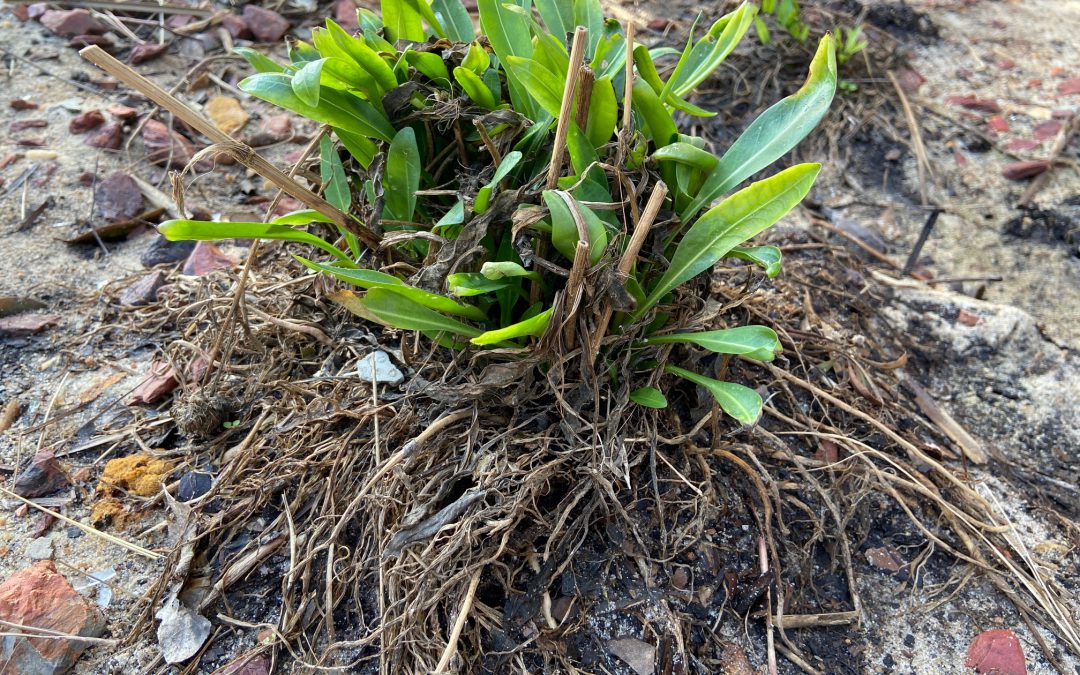
by Mary Salinas | Oct 14, 2020
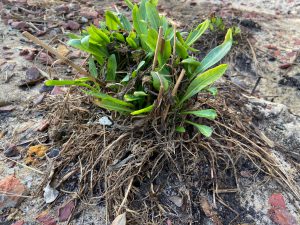
Stoke’s aster ‘Mel’s Blue’ 20 days after Hurricane Sally’s landfall. Notice how soil was washed away from root ball, all the leaves emerged post-hurricane. Photo credit: Mary Salinas, UF/IFAS Extension.
Hurricanes can wreak havoc in your landscape, but they can also reveal what plants are the toughest and most resilient. It’s a great learning opportunity.
A few weeks ago, Hurricane Sally came along and brought about 10 feet of surge and waves across my landscape and completely covered everything except the tallest trees for about 18 hours. (Fortunately, our house is on stilts and we did not have intrusion into our main living areas.)
As expected, the trees, including Dahoon Holly and Sweetbay Magnolia, took a beating but stayed intact. With their dense fibrous root system, most of the clumping native grasses also stayed put.
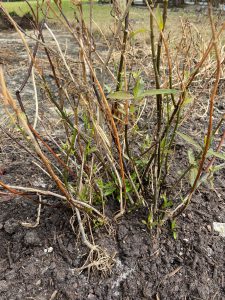
Perennial milkweed 3 weeks post-hurricane. New topsoil and compost now covers the rootball. Photo credit: Mary Salinas, UF/IFAS Extension.
The most surprising plant species that survived were about a dozen Stoke’s aster and 3 perennial milkweed. 4-5 inches of soil all around them was washed away, most of the roots were exposed, and the leaves were stripped or dead. The other perennials that had lived nearby were all washed away. To my surprise, within about 10 days after the storm, these two plant species started poking up new stems and leaves.
Here’s a list of some of the plants either in my yard or in the neighborhood that survived Hurricane Sally’s storm surge and may be suitable to add to your coastal landscape:
- Dahoon holly, Ilex cassine
- Muhly grass, Muhlenbergia capillaris
- Dwarf Fakahatchee grass, Tripsacum floridanum
- Perennial milkweed, Asclepias perennis
- Stoke’s aster, Stokesia laevis, specifically the cultivars ‘Mel’s Blue’ and ‘Divinity’
- Bottlebrush, Callistemon citrinus
- Gardenia, Gardenia jasminoides
- Bougainvillea, Bougainvillea spp.
- Flax Lily, Dianella tasmanica
- Crapemyrtle, Lagerstroemia spp.
- Cabbage palm, Sabal palmetto
- Canary Island date palm, Phoenix canariensis
- Sweetbay magnolia, Magnolia virginiana
- Augustinegrass, Stenotaphrum secundatum
- And, unfortunately, the rhizomes of the invasive torpedograss also survived.
For more information on salt tolerant and hurricane resistant plants, see:
UF/IFAS Gardening Solutions: Coastal Landscapes
UF/IFAS Gardening Solutions: Salt-tolerant Lawngrasses
UF/IFAS Gardening Solutions: Trees That Can Withstand Hurricanes
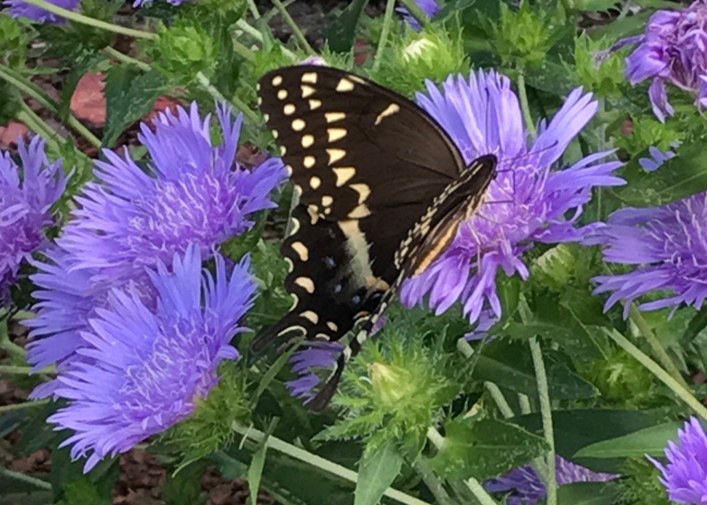
by Mary Salinas | Jun 22, 2017
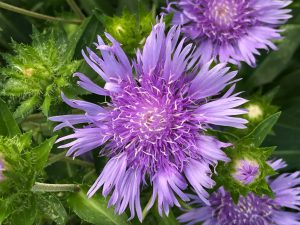
‘Mel’s Blue’ Stokes’ Aster. Photo credit: Mary Derrick, UF/IFAS Extension.
Florida is home to some of the most beautiful flowering perennials. An exceptional one for the panhandle landscape is Stokes’ aster (Stokesia laevis) as it is showy, deer resistant and easy to care for. Unlike other perennials, it generally is evergreen in our region so it provides interest all year.
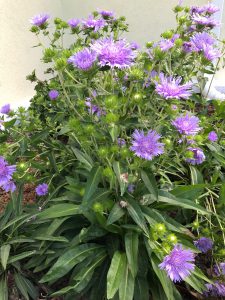
Upright habit and profuse blooming of ‘Mel’s Blue’ Stokes’ Aster. Photo credit: Mary Derrick, UF/IFAS Extension.
The original species of Stokes’ aster has purplish-blue flowers but cultivars have been developed with flowers in shades of white, yellow, rosy-pink and a deep blue. The flowers are large, eye-catching beauties that bloom in spring and summer. They also last well as a cut flower. You will find that bees and butterflies will appreciate their nectar! Remove spent flowers after blooms have faded in order to encourage repeat flowering.
A location in your landscape that provides part sun with well-drained rich soil is best for this perennial. Stokes’ aster is native to moist sites so it does best with regular moisture.
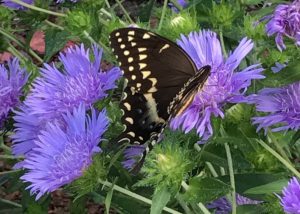
Stokes’ aster attracts butterflies like this black swallowtail. Photo credit: Mary Derrick, UF/IFAS Extension.
As with many perennials, the plant will form a large clump after a few years; this gives you the opportunity to divide the clump in the fall and spread it out in your landscape or share the joy with your gardening buddies.
For more information:
Gardening with Perennials in Florida
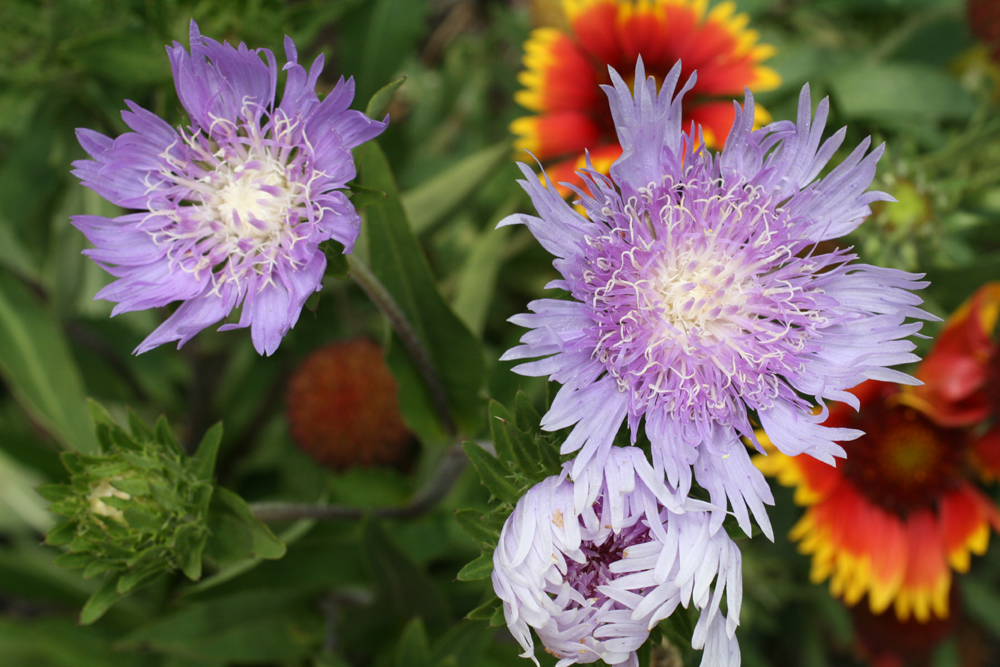
by Mary Salinas | Sep 9, 2015
After a few years, many perennial plants have grown so large that they need to be divided in order to be revived. Overcrowding causes them to bear fewer flowers and, sometimes, to die in the center. Fall is a good time to divide perennials that bloom in spring and summer and are now done blooming for the year. This is a great way also to expand your perennial beds or share some of your perennial favorites with friends and neighbors.
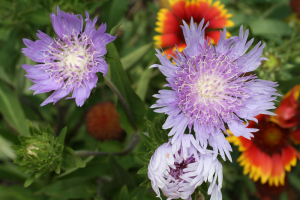
Vibrant blue Stokes’ aster. Photo credit: UF/IFAS.
Some examples of perennials to divide in the fall are:
- Stokes’ aster, Stokesia laevis
- Daylily, Hemerocallis spp.
- Black-eyed Susan, Rudbeckia hirta
- Yarrow, Achillea millefolium
- Crocosmia, Crocosmia spp.
- Flax lily, Dianella tasmanica ‘Variegata’
- Liriope, Liriope muscari
- Cast iron plant, Aspidistra elatior
The first step is to dig out the entire clump. If there is enough clearance in the garden bed, start digging about six inches out from the plant and dig straight down beyond the root zone. It’s best to get as much of the roots as possible to lessen the shock of transplanting. If the clump is too heavy to remove, make your divisions right there with a sharp blade, trowel or shovel. Often, you can just pull them apart with your hands.
Before replanting the divisions, consider adding some nutritious compost to those areas of your garden bed to ensure healthy plants. Be sure to replant as soon as feasible to protect the roots from drying out. After replanting, water the transplanted divisions well and mulch appropriately.
To explore further please see:
Gardening with Perennials in Florida
Propagation of Landscape Plants









